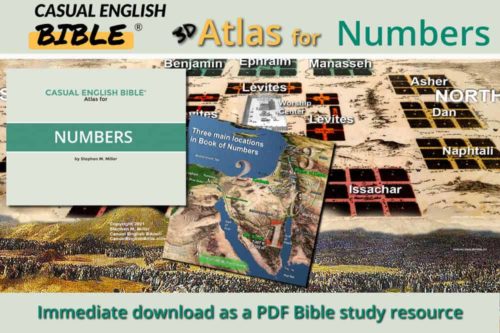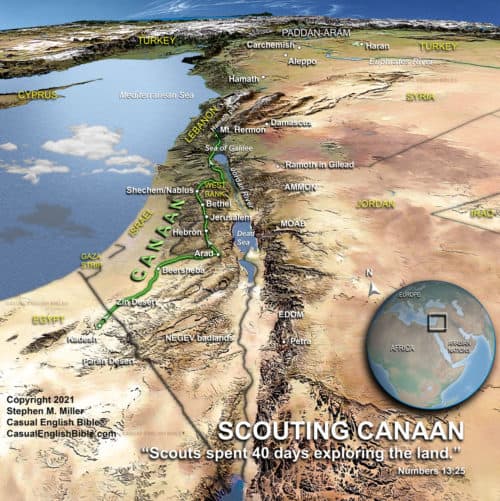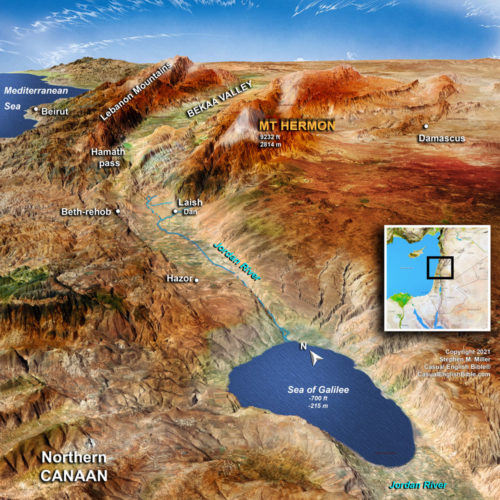Numbers 13
Israelite scouts size up Canaan
Moses assembles a patrol to scout Canaan
1The LORD told Moses, 2“Send a patrol to scout Canaan, the land I’m giving to the Israelites. Pick one man from each of the 12 tribes—each man a respected leader.” 3Moses did what the LORD said. There, in the Paran Desert, he selected one leader from every tribe to go on a scouting mission. 4Here are the names of the Israelite tribes and their scouts.Reuben: Shammua, Zaccur’s son
5Simeon: Shaphat, Hori’s son
6Judah: Caleb, Jephunneh’s son
7Issachar: Igal, Joseph’s son
8Ephraim: Hoshea, Nun’s son
9Benjamin: Palti, Raphu’s son
10Zebulun: Gaddiel, Sodi’s son
11Joseph’s son Manasseh: Gaddi, Susi’s son
12Dan: Ammiel, Gemalli’s son
13Asher: Sethur, Michael’s son
14Naphtali: Nahbi, Vophsi’s son
15Gad: Geuel, Machi’s son.
16These are the men Moses sent on a scouting mission into the land. Moses changed the name of Nun’s son Hoshea to Joshua.
Scouting Canaan
17Moses sent the patrol to scout Canaan. He gave them these orders, “Go north into the Negev badlands. Then press further north into the hills. 18I want to know what the land is like. I want to know how strong or weak the people are. And I want to know how many people live there.19What's the land like? Is it good or bad land? And what do the cities look like? Are they protected by walls or do the people live in open fields? 20Is the land good for growing anything? Are there many trees? I want you to show courage on this expedition. And bring back some fruit that grows.” Moses sent them on this mission at the end of Canaan’s harvest season, when grapes were ripening. [1] 21So they left the Israelite camp and scouted Canaan. They covered it all, north to south, from Zin Desert [2] on Canaan’s southern border to the northern border town of Rehob, [3] near the entrance into the Hamath [4] mountain pass.
22They headed up through the Negev until they came to the city of Hebron, which was built seven years before the Egyptians built Zoan. [5]Several tribes descended from the giant Anak [6] lived there: Ahiman, Sheshai, and Talmai. [7]
23On the return trip, when the scouts reached Cluster Valley, [8] they cut off a branch with one large cluster of grapes. They attached it to a pole. Two scouts carried it between them. The scouts also took pomegranates and figs. 24Cluster Valley got its name from of the cluster of grapes the scouts took.
Mixed scouting report
25Scouts spent 40 [9] days exploring the land. 26When they got back to where Moses and Aaron and the people of Israel were camped at the Kadesh [10] oasis in Paran Desert, they gave their report and showed the fruit they brought.27Here’s the report they gave: “We went where you told us to go. This is certainly a land where milk and honey flow like rivers. We picked this fruit there. 28The people who live there have strong defenses and large cities protected behind walls. We saw some descendants of the giant Anak. 29Amalekite [11] people live in the Negev. Further north, Jebusites [12] and Amorites [13] live in the central hill country. Along the seacoast is where some Canaanites live. Others live alongside the Jordan River.”
30The people started talking among themselves, so Caleb quieted them back down. And standing right there in front of Moses, he said, “Absolutely, we should go up there and take this land. We can do it.”
31Other scouts who had gone with him pushed back, “We can’t beat these people. They’re too strong for us.” 32These men gave a terrible report about what they saw. They told the Israelites, “The land we just explored is too big for us. If we tried to conquer all the people there, they would put us in the ground. These are huge people we’re talking about. 33That’s not all. We saw the giant Nephilim, ancestors of the giant Anak. Looking up at them, we felt like grasshoppers. And looking down at us, they felt we looked like grasshoppers, too.
Footnotes
Farmers harvested grapes anywhere from June through September. This was one of the last crops harvested, along with figs. Farmers harvested grain much earlier. Barley in March to May. Wheat in May to July. They plowed in September to October and then planted seeds for their next crop in November to December.
Most scholars say Zin Desert was in what is now Israel’s southern wasteland called the Arabah, and along with parts of the Negev. Arabah is a below-sea-level basin south of the Dead Sea. It’s along Israel’s border with Jordan. In earlier centuries, it referred to the entire Jordan Rift Valley, from the Sea of Galilee to the Gulf of Aqaba at the north tip of the Red Sea.
Possibly the city of Beth-rehob, west of Mount Hermon.
The Hebrew language calls the location lebo Hamath. This could mean the city of Lebo-hamath, in Lebanon, near where the Orontes River begins and the foot of Mount Hermon and Mount Lebanon. Or it could mean “entrance into Hamath” since lebo means “entrance.” Hamath was the name of a gateway into a mountain pass near Mount Hermon and Mount Lebanon. With either location, the idea was that the scouts traveled through all of Canaan, north to south.
We’re left guessing why the writer added this note about the ancient Egyptian city of Zoan, which once served as the capital of Egypt. One theory is that the writer was bragging that Hebron, the city that first declared David king of Israel, was older and richer in tradition and honor than the capital of Egypt.
Descendants of Anak—the Anakites—are described as giants (Deuteronomy 2:10-11).
Caleb, one of the 12 scouts, later drove out all three of these families, during the Israelite conquest of Canaan (Joshua 15:14). Joshua had given Caleb the land, but Caleb had to take it from the locals.
In Hebrew, it’s literally the valley of Eschol, a word that means “cluster,” as in cluster of grapes. Location of the ancient valley is unknown. Some have guessed Beit Ishkahil, about four miles (6 km) northwest of Hebron. But that location is uncertain. Scouts would have had to carry those grapes about 75 miles (120 km) to reach the Israelite camp, just beyond the southern border of what is now Israel. Typically, 20 miles (32 km) was a reasonable day’s walk.
“Forty days” was a way of saying several weeks, or a stretch of time much longer than most folks would want relatives to visit.
Scholars most often identify Kadesh, also called Kadesh Barnea, as the spring-fed oasis at Tel el-Qudeirat, on Egypt’s side of the border with Israel. Another contender is Ain Qadeis, also on Egypt’s side of the border. Bible writers put the location in different deserts: Zin Desert (Numbers 20:1) and Paran Desert (Numbers 13:26). Some theorize there were two Kadesh oases. West Kadesh and East Kadesh. Not many scholars seem to buy into that.
Amalekites were aggressive nomadic herders who would later raid the Israelites at harvesttime. Gideon put a stop to that (Judges 7).
Jebusites were the first people on record to live in what is now Jerusalem. David defeated them and chose Jerusalem as Israel’s capital.
Amorites were nomadic herders who seem to have migrated to Canaan from the river valleys in what is now Iraq. Scholars know very little about them, so far.
Discussion Questions
- Sorry, there are currently no questions for this chapter.







